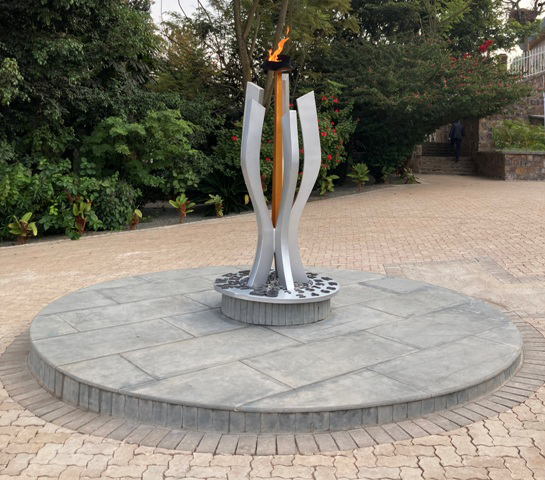
All best laid plans can sometimes go awry. I’d intended to go to the Kigali Genocide Memorial to learn more about Rwanda’s past but, on arrival, accompanied by another CHOGM delegate, Alastair Bradstock, representing the Oxford Policy Scholarship (which has as its objective ‘strengthening governments, elevating the rule of law’ in low and middle-income countries), there were two large white vans at the entrance, out of which emerged assorted camera equipment followed by the occupants who turned out to be a Canadian film crew, in anticipation of the Canadian Prime Minister’s imminent arrival. As Sandrine – who was overseeing arrivals the entrance gate – informed me, the memorial was now closed to ordinary visitors. Sensing our disappointment, she apologised profusely at having to turn us away, but the situation was non-negotiable. ‘Come back later in the afternoon and we might be able to accommodate you,’ she encouragingly said.
Undaunted, Eric, my now trusted taxi driver, had another suggestion: to visit the Campaign against Genocide Museum located on another hilltop which also happens to be the seat of the Rwandan parliament. Known as the ‘600’ it was where, for four days in April 1994, 600 members of the Rwandan Patriotic Front (the rebel army led by the now President, Paul Kagame) held out against government forces when fighting started following the death in a plane crash of President Juvenal Habyarimana. As we all know, the killing of the president signified the beginning of the horrific massacre of Tutsi Rwandans as well as Hutus who refused to take part in the bloodletting. Preserved on the building’s walls are the bullet marks as testimony to the fierce fighting which took place.
But the museum isn’t only about the military campaign, it also tells the story, from the current government’s perspective, of the origins of the genocide, how it was stopped and how peace and reconciliation were achieved, the exhibition rooms transitioning from dark to light in order to illustrate the very black period of Rwanda’s history and its emergence into the light.
The true horror emerged when, on Sandrine’s advice, we returned to the memorial in the late afternoon, by which time the VVIPs had concluded their tours.The statistics remain staggering: over a million dead over a period of around 100 days, most of them hacked to death with machetes, killed with grenades, buried alive or drowned, men, women and children. One exhibit was of a rusted chain which had bound together a husband and wife, who had been buried alive. The trauma of what the survivors endured is unimaginable; footage of those with tears in their eyes describing having lost their loved ones is heart breaking. Outside, the memorial is also a cemetery. A quarter of a million of those who perished lie together under large concrete gravestones, a wall of names listing the deceased. A series of gardens commemorate certain aspects: there is the garden of unity, the garden of division and the garden of reconciliation. There are also gardens for the children, for the ‘power of life’ and for self-protection (signified by a collection of cacti).
As I walked around the memorial museum and gardens, I knew that I was also following in the footsteps of HRH Prince Charles and the Duchess of Cornwall who, prior to fulfilling their CHOGM commitments, had seen the importance of visiting the memorial, as had Prime Minister Boris Johnson, before appearing unexpectedly at the Business Forum, accompanied by Lord Marland, Chairman of the Commonwealth Enterprise and Investment Council.
Even though my focus is on CHOGM 2022, I was glad to have faced the 1994 genocide, which is so much part of Rwandan history (although it is now forbidden for Rwandans to state whether they are Tutsis or Hutus and it is certainly inappropriate to ask). A strong part of the narrative is the response (or lack of) of the international community. Far from bolstering a UN presence, when ten Belgian UN peacekeeping soldiers were tortured and killed at the beginning of the genocide, the whole force was evacuated, as were any Europeans remaining in the country while the killing continued. Nearly thirty years later this failure to take action contributes to the guilt factor which western governments feel and explains why, perhaps, they are keen to ensure that the country prospers, preferring not to highlight heavy-handed governance and ongoing allegations by human rights groups of human rights abuses of dissidents criticising the government. Another series of rooms in the museum has displays of other genocides – the Holocaust, Cambodia, former Yugoslavia – a stark reminder that the spectre of genocide is common to all.
The Kigali Genocide Memorial, sponsored by the Aegis Trust, is both beautifully and creatively laid out. It is also exceedingly painful. As we emerged into the fading sunlight, Eric was waiting to take us on to my next destination. ‘Did you see the room with all the photographs of so many of those who’d been killed?’ he asked. ‘Why, yes,’ I replied. ‘It was so moving.’ I was about to say more but then he interjected. ‘My mother and father are there.’
Next up: CHOGM 2022 – the leaders meet



